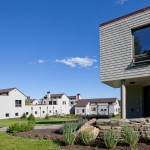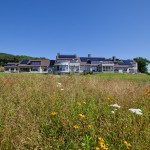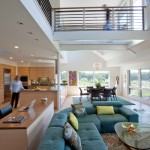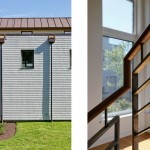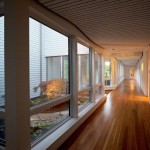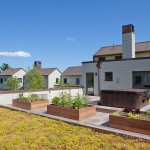Coastal Cohousing Community
Project Name: Coastal Cohousing Community
On a beautiful property that could have been subdivided and smothered by five freestanding houses, three couples created a cooperative community that gave them privacy, variety, and the prospect of aging in place, and at the same time preserved open land and its iconic view. The Owners wanted individual units connected internally to a commons, along with a separate guesthouse for visiting family and friends. Important goals for the project included fostering interaction between the residents; high expectations for energy efficiency; universal access; and durable, low maintenance materials.
A progressive zoning ordinance made it possible to construct a clustered, zero-lot-line subdivision if 40% of the land remained open space. The tight clustering of this project ensures that 80% of the property will remain open. The main building is a unified composition of three homes and a commons area complete with living and kitchen area, library, media room, workout room, art studio, roof deck with kitchen garden, central garage, and an apartment for a future caregiver. The separate guesthouse has a living area, bedrooms, and a basement playroom. Both buildings are sited and designed to maximize views, cross-ventilation, and opportunities for natural light and solar collectors. The design preserves individual privacy while encouraging interaction.
In the main building, the accessible entrance hallway connects the individual units and the commons. All the units are or can be made accessible: One unit is on a single level; another has a stair wide enough for a future lift, and the third has stacked storage closets for easy conversion to an elevator. An elevator makes the three floors of the commons accessible. The accessible first floor of the guesthouse includes a bedroom suite.
The super-insulated building envelope has very high levels of air tightness and utilizes high-performance triple-glazed fiberglass windows. A single wood-pellet boiler provides heat and hot water to the entire development, including the guesthouse. Solar shading devices and deep copper eaves reduce heat gain. “Chimneys” gather the mechanical intakes and exhausts, reducing penetrations and defining individual units. Flat roofs are vegetated to retain runoff.
Using utility invoices, we analyzed total energy use during a 12-month period. Total energy used is 25.6 kBtu/SF/yr. Of that total, 23.4 kBtu/SF/yr is from wood pellets, a renewable energy source.
The design reinterprets New England vernacular and blends green elements and durable materials into a contemporary, yet timeless, aesthetic.

